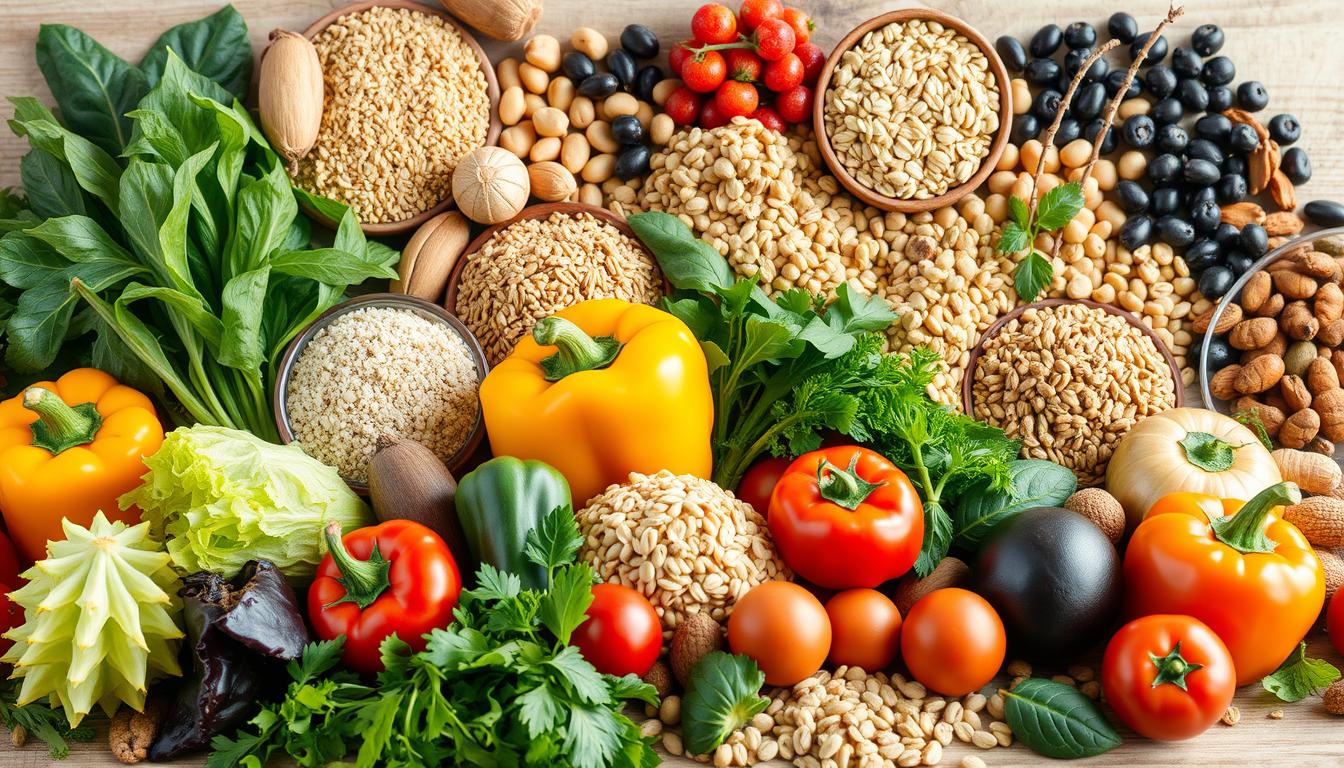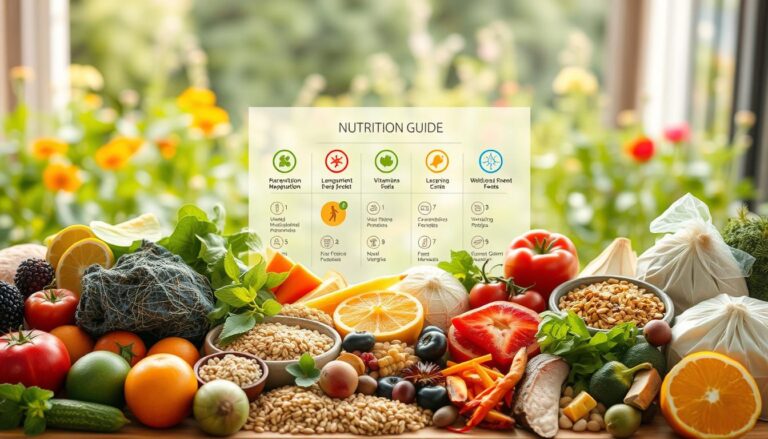Diabetes: 10 Best Foods to Manage Blood Sugar Naturally
Table of Contents
Living with diabetes can feel like navigating a complex maze. Your daily food choices are key to managing blood sugar and insulin levels. Knowing which foods help keep glucose stable is crucial for your health.
Diabetes management isn’t about cutting out food. It’s about choosing the right foods. By picking the right foods, you can help your body respond better to insulin. This leads to more stable blood sugar levels.
This guide will show you ten foods that can help manage diabetes well. These foods not only help control blood sugar but also boost your overall health and energy.
Key Takeaways
- Certain foods can naturally help manage blood sugar levels
- Diet plays a critical role in diabetes management
- Whole, nutrient-dense foods are essential for insulin control
- Strategic food choices can reduce diabetes-related health risks
- Nutrition is a powerful tool in diabetes prevention and management
To get better results, you can benefit from the benefits of this nutritional supplement
Understanding Blood Sugar Management Through Diet
Managing type 1 and type 2 diabetes begins with knowing how food affects your blood sugar. Your diet is key to controlling glucose levels and keeping you healthy.
The American Diabetes Association says there’s no one-size-fits-all diet. What you eat greatly affects your blood sugar. So, being aware of your diet is crucial for managing diabetes well.
Nutrition’s Critical Role in Diabetes Control
Controlling diabetes through diet is essential. Here are important nutrition tips:
- Spread carbohydrate intake throughout the day
- Choose low glycemic index foods
- Prioritize whole grains and fiber-rich options
- Monitor portion sizes
Impact of Food Choices on Blood Glucose
Various foods have different effects on blood sugar. High glycemic index foods like white rice and bread can quickly raise blood sugar. On the other hand, whole grains offer steady energy.
| Food Type | Blood Sugar Impact | Recommended Intake |
|---|---|---|
| Whole Grains | Stable Blood Sugar | 3-5 servings daily |
| White Bread | Rapid Sugar Spike | Limit consumption |
| Leafy Vegetables | Minimal Impact | Unlimited |
Benefits of Natural Blood Sugar Management
Making smart food choices can help manage blood sugar naturally. This can lower your need for medication and boost your health. Regularly checking your glucose levels and eating a balanced diet helps you control your diabetes.
Leafy Greens and Their Blood Sugar-Lowering Properties
Leafy green vegetables are packed with nutrients that help manage blood sugar. They are great for people with diabetes. These foods can prevent both low and high blood sugar levels.
Leafy greens are low in carbs that raise blood sugar. This makes them perfect for controlling blood sugar levels. They are a great choice for those with diabetes.
Top Leafy Greens for Blood Sugar Management
- Spinach: Rich in alpha-lipoic acid, which may help alleviate diabetes-related symptoms
- Kale: Packed with antioxidants that support overall metabolic health
- Swiss Chard: Contains nutrients that help regulate blood sugar
- Collard Greens: High in fiber and low in calories
Research shows leafy greens are good for diabetes management. The USDA suggests eating 2 to 4 cups of veggies a day. Leafy greens are a key part of this.
| Leafy Green | Fiber Content | Key Nutrients |
|---|---|---|
| Spinach | 2.2g per cup | Vitamin K, Iron, Alpha-lipoic Acid |
| Kale | 1.3g per cup | Vitamin A, Vitamin C, Calcium |
| Swiss Chard | 3.7g per cup | Magnesium, Potassium, Vitamin K |
Eating leafy greens can help keep blood sugar stable. They are low in carbs and full of nutrients. This makes them a natural choice for managing blood sugar.
Fatty Fish for Diabetes Management
Managing diabetes means making smart food choices. Fatty fish is a key player in a diabetic diet. It helps control blood sugar and keeps your heart healthy.
Top Fatty Fish for Diabetic Nutrition
Not all fish is good for diabetes. The best fatty fish are:
- Salmon
- Sardines
- Herring
- Mackerel
- Anchovies
Omega-3 Fatty Acids: A Diabetes Defense
Omega-3 fatty acids in these fish are vital for diabetes care. Studies show that eating oily fish can cut type 2 diabetes risk by up to 38.6%. These nutrients:
- Reduce inflammation
- Lower triglyceride levels
- Improve insulin sensitivity
Recommended Consumption Guidelines
To get the most from fatty fish, follow these tips:
- Have 3-4 ounces per meal
- Eat 2-3 servings a week
- Choose low-mercury fish
- Grill or bake them instead of frying
Adding fatty fish to your diet can boost your insulin therapy and metabolic health. The right foods are key to managing diabetes well.
To get better results, you can benefit from the benefits of this nutritional supplement
Avocados: The Perfect Diabetes-Friendly Fat
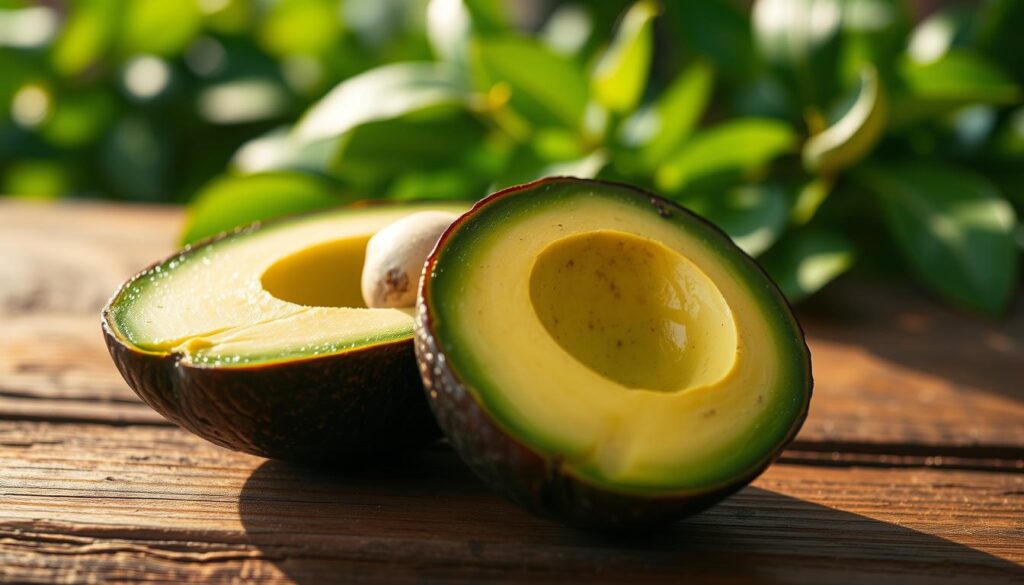
Avocados are a nutritional powerhouse for people with diabetes. They are creamy and offer great benefits for controlling blood sugar. Studies show they can help prevent diabetes and manage metabolic health.
A study from the Mexican National Health and Nutrition Survey found something interesting. Women who ate 30-38 grams of avocado a day had lower odds of getting diabetes. Avocados are full of nutrients that help manage blood sugar.
- Zero naturally occurring sugars
- High fiber content
- Rich in unsaturated healthy fats
- Low carbohydrate profile
With over 38.4 million Americans with type 2 diabetes, what we eat matters a lot. Avocados are a great choice for our health. They help keep blood sugar and insulin levels in check.
Nutritional benefits of avocados include:
- Supports insulin sensitivity
- Promotes satiety
- Helps manage blood sugar levels
- Reduces risk of metabolic disorders
The American Diabetes Association says to eat nutrient-dense foods like avocados. Eating one avocado a day can help improve your diet and health.
Avocados: Nature’s delicious solution for blood sugar control
Diabetes and the Power of Whole Grains
Whole grains are a nutritional powerhouse for those with type 1 and type 2 diabetes. They offer a strategic way to control blood sugar. This is because they are packed with vitamins, minerals, and fiber that help regulate insulin.
Learning about whole grains can change how you eat. For people with diabetes, the right grains can help keep blood sugar stable.
Top Whole Grain Options for Diabetics
- Quinoa: Contains 8 grams of protein and 5 grams of fiber per cup
- Oatmeal: Provides 4 grams of fiber per half-cup serving
- Brown rice: Offers 3 grams of fiber per cup
- Barley: Rich in beta-glucan, which helps manage blood sugars
- Buckwheat: Contains three times more fiber than all-purpose wheat flour
Fiber Content and Glycemic Impact
Fiber is key in managing diabetes. Whole grains have more fiber than refined grains. This slows digestion and prevents quick blood sugar spikes. The Dietary Guidelines for Americans suggest 22 to 34 grams of fiber daily, based on age and sex.
Portion Control Guidelines
When adding whole grains to your diet, watch your portions. Try to fill about a quarter of your plate with whole grain carbs. Start with small amounts and increase slowly to avoid discomfort and keep insulin levels stable.
To get better results, you can benefit from the benefits of this nutritional supplement
Beneficial Effects of Nuts and Seeds
Nuts and seeds are great for managing blood sugar and improving health for people with diabetes. They are full of nutrients that help keep blood sugar levels stable. This can prevent both low and high blood sugar.
Studies show that eating nuts can be very beneficial. A good amount is about 1 ounce (28 grams). This size can help keep blood sugar levels steady and lower heart disease risks.
- Almonds can positively affect blood sugars
- Walnuts help reduce LDL cholesterol
- Pistachios improve cholesterol ratios
- Brazil nuts may lower insulin levels
Different nuts offer unique advantages for diabetes management:
| Nut Type | Health Benefits | Serving Size |
|---|---|---|
| Almonds | Blood sugar control | 23 almonds |
| Walnuts | Cholesterol reduction | 14 halves |
| Pistachios | Triglyceride management | 49 nuts |
| Cashews | Blood pressure support | 18 nuts |
When adding nuts to your diet, it’s important to control portions. A small handful or quarter cup is best. This helps keep blood sugar levels right without too many calories. Careful glucose monitoring helps see how nuts affect your blood sugar.
By adding nuts and seeds to your meals, you can help manage diabetes. You also get to enjoy tasty and healthy foods.
Berries and Their Impact on Blood Sugar
Finding the right foods for your diabetic diet can be tough. But berries are a tasty and healthy choice to help control blood sugar. They are full of nutrients that support your insulin therapy and health.
Berries are full of nutrients that help people with diabetes. They have a low glycemic index and are packed with good stuff. This makes them great for keeping blood sugar stable.
Antioxidant Properties
The bright colors of berries are not just pretty. They are full of antioxidants called anthocyanins. These compounds are great for your health by fighting inflammation and keeping cells healthy.
- Blackberries contain 64 calories and 7.6 grams of fiber per cup
- Strawberries offer only 46 calories with 3 grams of fiber
- Blueberries provide essential nutrients with a low glycemic impact
Best Berry Types for Diabetes
Not all berries are the same for managing blood sugar. Some of the best include:
- Strawberries (GI of 25)
- Cherries (GI of 20)
- Raspberries (GI of 53)
Serving Suggestions and Timing
Adding berries to your diet needs some planning. Try to eat one serving (about 1 cup) between meals. This keeps your blood sugar steady and gives you important vitamins and minerals.
“Berries are nature’s sweet solution for diabetes management” – Nutrition Experts
A study with over 200,000 people showed eating berries can lower type 2 diabetes risk by 23%. Choosing the right berries can really help your health.
Greek Yogurt and Probiotic Benefits
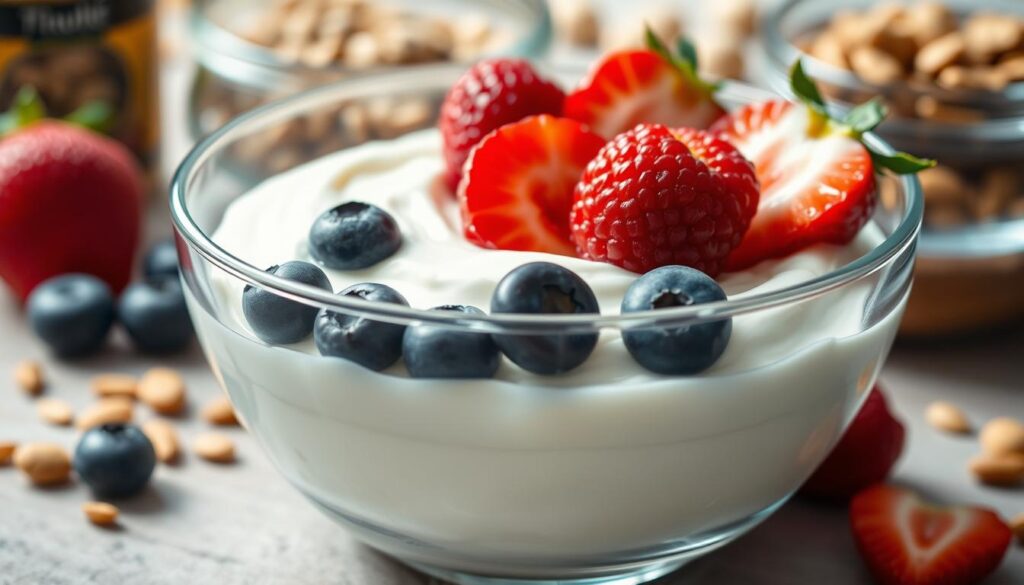
Greek yogurt is a great help in managing diabetes and blood sugar. It has fewer carbs than regular yogurt, making it good for those watching their sugar intake. With only 6-8 grams of carbs per serving, it’s a top pick for blood sugar monitoring.
Greek yogurt is full of protein, which is good for diabetes control. Here’s why:
- High protein content helps reduce appetite
- Lower carbohydrate levels prevent insulin spikes
- Promotes stable blood sugar levels
- Supports weight management strategies
The probiotics in Greek yogurt are key for gut health. Research shows that probiotic yogurt can improve insulin sensitivity and lower diabetes-related inflammation. A 2023 study found that eating 200 grams of probiotic yogurt daily lowered hemoglobin A1c levels.
When picking Greek yogurt for diabetes, follow these tips:
- Choose varieties with less than 10g of sugar per serving
- Look for yogurts with Live & Active Cultures (LAC) seal
- Opt for plain, unsweetened versions
- Check protein content (aim for more than 12g per serving)
Adding Greek yogurt to your diet can be tasty and healthy. It helps with diabetes management and gives you important nutrients and health benefits.
Plant-Based Proteins for Blood Sugar Control
Managing type 1 and type 2 diabetes means making smart food choices. Plant-based proteins are great for keeping blood sugar in check. With many facing insulin resistance, knowing about plant proteins is key.
Plant proteins are great for diabetes management. They give important nutrients and help keep blood sugar stable. They don’t have the bad fats found in animal proteins.
Legumes: Nutritional Powerhouses
Legumes are top picks for plant-based proteins. They’re packed with nutrients and help manage diabetes well:
- Contain 15 grams of protein per cup
- Provide 15 grams of fiber
- Classified as low-glycemic-index foods
Protein-Rich Vegetables
Some veggies are high in protein and help control blood sugar. Eating non-starchy veggies, which make up half your plate, is good. They give important nutrients without raising blood sugar.
| Vegetable | Protein (g) | Fiber (g) |
|---|---|---|
| Edamame | 18 | 8 |
| Lentils | 15.5 | 13.5 |
| Split Peas | 16 | 16 |
| Chickpeas | 14.5 | 12.5 |
Meat Alternatives
Plant-based protein alternatives help control blood sugar. Adding these proteins can lower insulin resistance. They offer a lasting way to manage diabetes.
Protein foods should fill one-quarter of your plate for optimal diabetes nutrition.
Choosing plant-based proteins wisely helps your body monitor glucose better. You get to enjoy tasty, healthy meals too.
Creating a Balanced Diabetes-Friendly Meal Plan
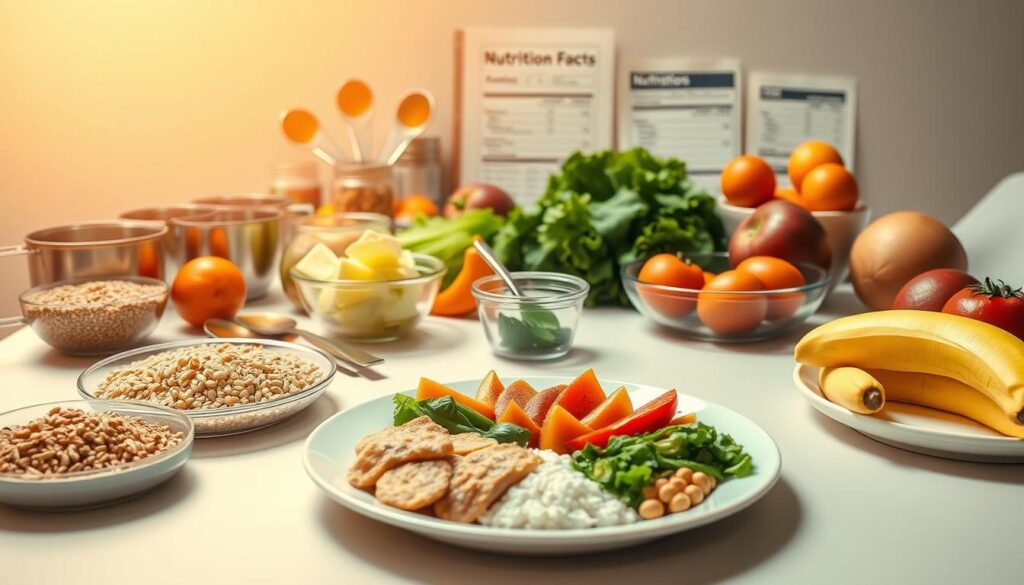
Managing blood sugar levels is all about planning your meals wisely. The plate method is a simple way to make balanced meals. It helps avoid hypoglycemia and hyperglycemia and supports your insulin therapy.
A good diabetes-friendly meal plan has three main points:
- Balanced nutrient distribution
- Consistent carbohydrate intake
- Strategic food choices
The plate method gives you a clear guide on how to arrange your meals:
| Plate Section | Food Group | Percentage |
|---|---|---|
| First Half | Non-Starchy Vegetables | 50% |
| First Quarter | Lean Protein | 25% |
| Second Quarter | High-Fiber Carbohydrates | 25% |
Most people need 1,200 to 1,600 calories a day. Carbohydrates should be between 107g to 170g. Your exact needs might be different, so always talk to a healthcare professional.
Here are some tips for meal planning:
- Check your blood sugar levels often
- Match carbs with your activity level
- Pick foods with a low glycemic index
- Make sure your meals are varied
Pro tip: Walking for 2-5 minutes after meals can help lower blood sugar levels naturally.
Conclusion
Managing diabetes is a complex journey that needs careful dietary choices. Your diet is key to controlling blood sugar and preventing serious health issues. With over 537 million people worldwide with diabetes, knowing how to eat is crucial for health.
We’ve looked at foods that help control blood sugar naturally. Adding leafy greens, fatty fish, whole grains, and the right proteins can make a big difference. Studies show that changing your lifestyle can cut the risk of Type 2 diabetes by about 58%.
Your diet plan should be tailored to you. Work with healthcare experts to create a diet that fits your needs. Eating right, exercising, and controlling portions can keep your blood sugar stable. This helps improve your life quality.
Diabetes affects millions worldwide, but good nutrition can change your health path. Stay updated, stay driven, and see how a well-thought-out diet can transform your life.
FAQ
What are the best foods for managing diabetes naturally?
Foods like leafy greens, fatty fish, avocados, and whole grains are great for diabetes. Nuts, seeds, berries, Greek yogurt, and plant-based proteins are also good. They help control blood sugar and improve health for both type 1 and type 2 diabetes.
How do leafy greens help with diabetes management?
Leafy greens are full of nutrients and low in carbs. They help keep blood sugar levels stable. They also provide important vitamins and minerals, making them a key part of a healthy diet for diabetics.
Can people with diabetes eat fruits like berries?
Yes, berries are a great choice for diabetics. They’re packed with antioxidants and have a low glycemic index. Eating them in the right amounts can help manage blood sugar levels.
Why are fatty fish recommended for diabetics?
Fatty fish are full of omega-3s, which help control blood sugar and heart health. They’re especially good for diabetics because they reduce the risk of heart problems.
How do whole grains benefit diabetes management?
Whole grains have more fiber and a lower glycemic index than refined grains. They help regulate insulin and provide steady energy. They’re a key part of a balanced diet for managing diabetes.
Are nuts and seeds good for diabetics?
Yes, nuts and seeds can prevent blood sugar spikes and provide healthy fats. They’re rich in nutrients and help keep glucose levels stable when eaten in moderation.
What role do plant-based proteins play in diabetes management?
Plant-based proteins like legumes and meat alternatives help keep blood sugar stable. They’re full of nutrients and have a low glycemic index. They support health for both type 1 and type 2 diabetes.
How important is diet in managing diabetes?
Diet is very important for managing diabetes. The right foods can control blood sugar, improve insulin sensitivity, and reduce complications. It’s important to work with healthcare professionals to create a personalized diet plan.
Can I reverse diabetes through diet?
While diet can’t reverse diabetes, especially type 1, it can improve blood sugar control. A well-planned diet can also reduce medication needs for type 2 diabetes and manage the condition better.
How often should I monitor my blood sugar when changing my diet?
How often to check blood sugar depends on your diabetes type and treatment. When changing your diet, check more often. Always consult with your healthcare provider to adjust your monitoring and treatment plan.
To get better results, you can benefit from the benefits of this nutritional supplement

